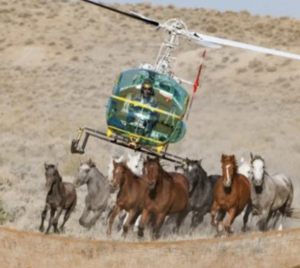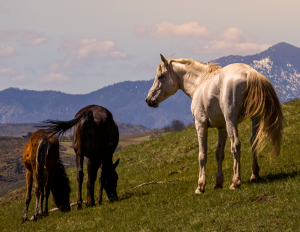Hear me out. I know this may seem out of left field. Wild horses and burros were granted protection by Congress in 1971 deemed “living symbols of history.” With the 1971 Wild Free Roaming Horses and Burro Act, Congress outlawed, capture, branding, harassment or killing of wild horses and burros. And As a result, thinking of them living their best lives puts a smile on my face. However not so much after digging a bit more into certain practices of the U.S. Bureau of Land Management (BLM), responsible for their “protection” oversight and managing the U.S. wild lands. What I learned was disheartening.

wild horses
credit
Wild Horse Fire Brigade
Some of their practices have been criticized and are under scrutiny. For example, according to an article in Reasons To Be Cheerful by Michaela Haas, roughly 60,000 of these horses are being kept indefinitely, even long term, in BLM corrals. And that does not sound to me like they are living their best wild/free lives.
Enter William E. Simpson, Naturalist, Conservationist, and Founder of nonprofit Wild Horse Fire Brigade. He wants BLM to release them strategically within the nation’s 110 million acres of designated wilderness and open areas where “they could keep grasses and vegetation in check as keystone herbivores.”
His perspective comes from years as a practicing veterinarian, and first-hand experience in 2018 when the 38,000 acre Klamathon fire tore through the hills near his remote ranch. Rather than evacuate as warned William and his wife stayed behind and guided firefighters through the dirt roads of the remote area. In the aftermath he had an Aha! moment realizing his ranch and the surrounding land had been spared. You see he had befriended and become healer and friend to a herd of wild horses.
It started with a thin sickly pregnant mare who he fed oats containing antibiotics. The next day she brought her family back and over the years he tended a number of horses for injuries from barbed wire or gashes from encounters with mountain lions. According to William, “It’s all voluntary. They’re wild. You aren’t going to put a harness on them. Some let me help them more than others. So, as a result of their nearby grazing, fire danger near his home was reduced. “Each wild horse consumes 30 pounds of grass and brush a day,” say Williams, “They reduced the fuel, keeping the wildfire at bay.”
Another BLM criticism, in 2021 hundreds of wild horses were removed from Sand Wash Basin in Colorado to make space for private ranchers’ live stock. Let’s not speculate on what or whether lobbying or other politics was at play. I will, however, point out the resulting negative environmental impacts on a wilderness area of such a change. Wild horses move through areas quicker than livestock allowing grass and flora to quickly recover. Also, livestock digest plant and flora seeds. Wild horses don’t. They actually aid distribution of undigested native plant seeds, through their manure.
His idea is not a new concept. The use of large herbivores in prevention of wildfire damage already has a track record in Europe.

Reasons To Be Cheerful
He has also published findings of a 5-year close range study, titled “Impact Of Wild Horses On The Wilderness, Landscape and Wildfire,” on wild horse behavioral ecology and how their relationships with other native species flora and fauna can benefit Western American wilderness area. While the BLM’s position is that the agency does not have legal authority to release and strategically relocate the wild horses to aid in wildfire prevention a lawyer working with William E. Simpson argues fire departments and counties have authority to request any number of horses for fire protection. The BLM counters, for some reason, maybe they are compelled to do so, that releasing and relocating wild horses for fire prevention will result in uncontrolled population growth of wild horse. The counter to that is historic data demonstrates that predators such as mountain lions/pumas and bears have, and would, keep the wild horse population in check.
In addition to Edward’s nonprofit the Wild Horse fire Brigade, American Wild Horse Conservation, (AWHC) has been taking a stance on the protections and positive environmental benefits of wild horses and burros since 2011. Their litigation includes contesting such things as the BLM sterilizing and castrating wild horses, treating public lands as private and favoring for-profit ranchers. One example is the contentious litigation and disputes involving BLM in the Wyoming Checkerboard land. Checkboarding references the intermingling of the land of two or more owners. In the case of the Wyoming Checkerboard this area contains 4 wild horse Herd Management Areas and 2 million acres of co-mingled public and private land.
AWHF has also undertaken efforts to stop removal of wild horses from Jakes Wash and other area in Nevada as well as Utah and Idaho. And intervening and winning lawsuits against ranchers seeking to remove wild horses from public lands. They also take the position that in remote areas of the West mountain lions and other apex predators “balance entire ecosystems including regulating wild horse populations.” And, that government mountain lion kill programs are killing hundreds of these natural predators to wild horse, on public lands, annually.
Edward believes the strategic relocation of wild horses as a win-win-win, saving taxpayer dollars spent of land management, allowing wild horses to live free and reducing danger from wildfires. Wild Horse Fire Brigade’s website actually lists 12 benefits of free-living wild horses; natural reseeding of native plants, much less negative soil disruption (which is bad for wilderness ecosystems) than livestock, their presence is important to the survival of co-evolved wilderness fauna helping naturally maintain important native cover crops, their grazing overlaps only 1% with deer compared to the 4% gazing overlap for cattle and deer, and wild horse presence can help re-establish elk and deer populations.
You can learn more about the plight of wild horses, find volunteer opportunities and ways to support by visiting https://www.wildhorsefirebrigade.org , https://www.skydogranch.org, and https://home.americanwildhorse.org
